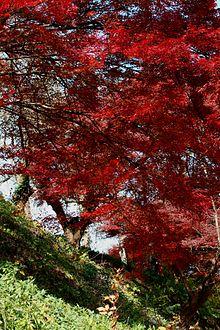
Hi Everybody!!
Prepare to be Wowed by a tree! Yes, the Japanese Red Maple Tree will dazzle You. This is a small, beautiful tree that grows well in the shade of larger trees. He looses his leaves in winter and produces new, flame red leaves in spring. I have two cultivars among the white azaleas in Mom's Garden. I have shared info below from Wikipedia about the "Acer Palmatum". Links are from the G+ Albums in the spring flowers photostudies. Google Search has options to purchase one of these trees. Enjoy!

https://plus.google.com/u/0/photos/117645114459863049265/albums/6000460793439400801




https://plus.google.com/u/0/photos/117645114459863049265/albums/5997515607780164481


https://plus.google.com/u/0/photos/117645114459863049265/albums/6000465039378063985




https://en.wikipedia.org/wiki/Acer_palmatum
Acer palmatum
From Wikipedia, the free encyclopedia
Acer palmatum, called Japanese Maple or Smooth Japanese Maple(Japanese: irohamomiji, イロハモミジ, or momiji, 紅葉) is a species of woody plant native to Japan, North Korea, South Korea, China, eastern Mongolia, and southeast Russia.[2] Many different cultivars of this maple have been selected and they are grown worldwide for their attractive leaf shapes and colours.
| Japanese Maple | |
|---|---|
 | |
| Japanese Maple foliage= Eudicots | |
| Scientific classification | |
| (unranked): | Rosids |
| Order: | Sapindales |
| Family: | Sapindaceae[1] |
| Genus: | Acer |
| Species: | A. palmatum |
| Binomial name | |
| Acer palmatum | |
Description[edit]
Acer palmatum is a deciduous shrub or small tree reaching heights of 6 to 10 m (20 to 33 ft), rarely 16 metres (52 ft), often growing as an understory plant in shady woodlands. It may have multiple trunks joining close to the ground. In habit, it is often shaped like a hemisphere (especially when younger) or takes on a dome-like form, especially when mature.[3] The leaves are 4–12 cm long and wide, palmately lobed with five, seven, or nine acutely pointed lobes. The flowers are produced in small cymes, the individual flowers with five red or purple sepals and five whitish petals. The fruit is a pair of winged samaras, each samara 2–3 cm long with a 6–8 mm seed. The seeds of Japanese maple and similar species require stratification in order to germinate.[3][4]
Even in nature, Acer palmatum displays considerable genetic variation, withseedlings from the same parent tree typically showing differences in such traits as leaf size, shape, and colour.[3]
Cultivation and uses[edit]
Japanese Maple has been cultivated in Japan for centuries and in temperateareas around the world since the 1800s.[3] The first specimen of the tree reached England in 1820.
When Swedish doctor-botanist Carl Peter Thunberg traveled in Japan late in the eighteenth century, he secreted out drawings of a small tree that would eventually become synonymous with the high art of oriental gardens.[5] He gave it the species name palmatum after the hand-like shape of its leaves, similar to the centuries old Japanese names kaede and momiji, references to the 'hands' of frogs[6] and babies,[citation needed] respectively.
For centuries Japanese horticulturalists have developed cultivars from maples found in Japan and nearby Korea and China. They are a popular choice for bonsai[7] enthusiasts and have long been a subject in art.
Numerous cultivars are currently available commercially and are a popular item at garden centres and other retail stores in Europe and North America. Red-leafed cultivars are the most popular, followed by cascading green shrubs with deeply dissected leaves.[3]
Preparations from the branches and leaves are used as a treatment in traditional Chinese medicine.[8]
Growing conditions[edit]
Acer palmatum includes hundreds of named cultivars with countless forms, colours, leaf types, sizes, and preferred growing conditions. Heights of mature specimens can range from 0.5 m to 25 m, depending on type. Some tolerate sun, and others like shade. Almost all are adaptable and blend well with companion plants. The trees are particularly suitable for borders and ornamental paths because the root systems are compact and not invasive. Well drained soil is preferred, and the trees grow strongest when they are not over-fertilized. Many varieties of Acer palmatum are successfully grown in containers.[9]
Pruning[edit]
If space is not a constraint, no pruning is necessary except to remove any dead branches. Some growers prefer to shape their trees artistically or to thin out interior branches to better expose the graceful main branches, especially in winter.


https://plus.google.com/u/0/photos/117645114459863049265/albums/6000457449043579025





https://plus.google.com/u/0/photos/117645114459863049265/albums/6000482494960727025


...this is brendasue signing off from Rainbow Creek. See You next time!

O+O





No comments:
Post a Comment
Hi Everybody! Please say hello and follow so I know you are here! Due to the inconsideration of people trying to put commercials on my blog comment area, I have restricted use of anonymous posts. Sorry that some hurt all.
My public email is katescabin@gmail.com No spammers or trolls